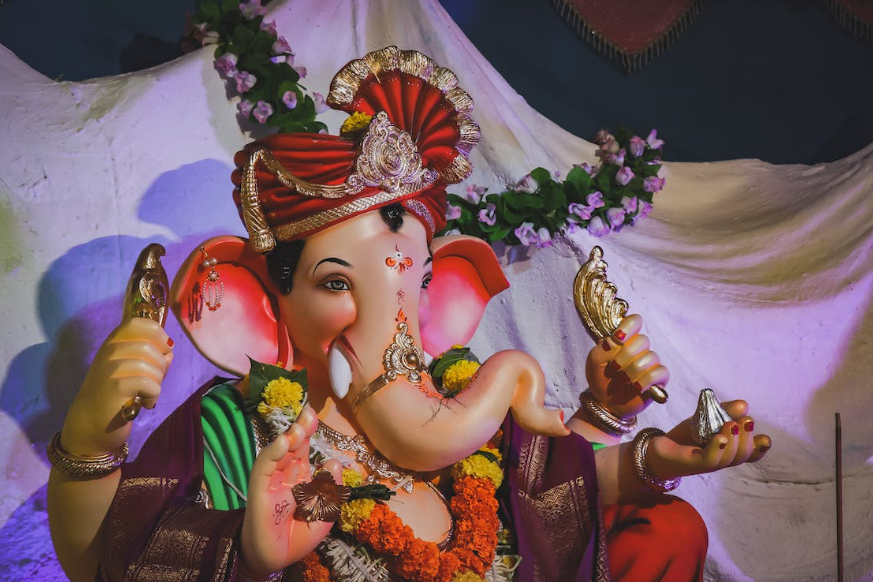Does Manifestation Come From Hinduism?
Manifesting helps us achieve our utmost desires. But, where did manifesting come from? Let’s now try to understand Hinduism and how it gave birth to manifesting.

Selfpause Affirmation App
Download the app to get 1,000’s of affirmation meditations and everything you need to write, record and listen to your own.
Many of us have been trying to make our wants come true by manifesting them since we learned that the universe mirrors our wishes back to us. It appears that all it takes is a strong determination, a few changed words, and faith in the cosmos. Even if it’s partially accurate, real manifestation starts with complete knowledge of its background and ideal ways to conduct oneself. Let’s turn on a candle and journey into the realm of manifestation.
Even though it has recently gained enormous popularity, Buddhism and Christianity are just two of the many traditions that have acknowledged manifestation in the past. However, Hinduism, the world’s oldest religion, may be attributed with many of its current customs. Many of the current adaptations of Hinduism that are used in “Western Spirituality” today, such as the terminology chakras, third eye, manifestation, and yoga, have their roots in this ancient religion. Ancient eastern religions are in danger of being forgotten about and denied credit for many common spiritual activities due to the popularity of “Western Spirituality.”
Manifesting enables us to fulfill our deepest wishes. But from whom did manifestation originate?
Let’s first define Hindusim,
What is Hinduism?

Hinduism is a religion that originated in the Indian subcontinent. It is considered the world’s oldest religion, and some practitioners believe it to be 5,000 years old. Hinduism is also the third largest religion in the world, with approximately 1 billion followers.
There are many different sects and schools of thought within Hinduism, but there are also some common beliefs that connect Hindus together. These include the belief in karma (the idea that good deeds lead to good outcomes and bad deeds lead to bad outcomes), reincarnation (the belief that souls are reborn into new bodies after death), and dharma (the moral code that governs human behavior).
Hinduism is said to have been the source of the manifestation. The Hindu Vedas are regarded to include the first allusions to manifesting techniques, with the idea that the cosmos is produced according to one’s ideas dating back to at least the 2nd Century BC.
Let’s try to determine whether Hinduism created manifesting or whether it came from Christianity or another faith.
Did Manifesting Come From Hinduism?

The law of attraction is often believed to have originated in Hinduism, and these individuals are correct.
If you examine the many different faiths, you will find that the terms “manifest” and “manifestation,” as well as the principles of how to manifest, are employed in each one. This makes us think that Hinduism is the source of manifestation.
Hinduism can be introduced in a variety of ways, but they always begin with “The Vedas,” which are divided into four groups:
The Rig Veda: a collection of over 1,000 hymns that are dedicated to the 33 gods of the Vedic pantheon. It is the earliest writing that is thought to be older than 4,000 years. It also goes by the names The Knowledge Veda and Wisdom Veda.
The Sama Veda: a compilation of melodies and chants that were used in Vedic rituals. This is a selection of musical works. It is made up of passages directly extracted from The Rig Veda and is said to be the essence of the Vedas. It was composed later but is thought to predate The Yajur Veda.
The Yajur Veda: This veda contains sacrificial formulas and prayers. It is said to be between 5,000 and 4,000 years old (sixth or seventh century BC) and was written by Yajurveda. It offers instructions for priests who offered sacrifices, and it was connected to routine activity.
The Atharva Veda: The final veda focuses on spells, charms, and other magical practices. The Book of Protection is another name for it. Between 1500 BC and 1000 BC, four centuries are said to have passed while it was being put together as a collection. It includes hymns about charms and spells that may be used to treat illnesses and combat injuries. A number of mantras are also included.
The Vedas are said to be the oldest sacred texts in Hinduism, with the Rig Veda being the oldest of the four. These documents date back to at least 1500 BCE but could be much older.
Despite their age, the Vedas provide detailed instructions on how to live a moral and successful life. This is done through the practice of yoga, meditation, and other self-disciplines.
The Vedas also contain the earliest allusions to manifesting techniques. The idea that the cosmos is produced according to one’s ideas can be found in the 2nd Century BC Hindu text, the Brihadaranyaka Upanishad.
In this Upanishad, it says:
“As a man thinks in his heart, so is he.”
This statement is very similar to what we now know as the law of attraction. The law of attraction states that our thoughts and feelings create our reality. So, if we want to manifest something into our lives, we need to think and feel as if it is already happening.
The Brihadaranyaka Upanishad also contains another interesting statement about manifestation:
“It is desire that is the root of action.”
Again, this is in line with the law of attraction. Our desires are what fuel our actions. So, if we want to manifest something, we need to have a strong desire for it.
So, it’s clear that the Vedas contain some of the earliest references to manifesting. But did Hinduism create manifesting or did it come from another source?
It’s possible that the law of attraction was known long before the Vedas were written. After all, these texts date back over 2,000 years.
Let’s examine the term manifest in Hinduism after looking at the introduction to Hinduism.

You’ll notice that the description of manifesting is exactly what a practice known as Yoga Nidra that involves visualization calls for is akin to.
Similar to Yoga Nidra, which is characterized as “A state of consciousness in which one’s awareness of multiple levels of existence is greatly improved,” this involves the person being aware and envisioning a result without necessarily desiring for it to happen.
Manifestation comes from the Sanskrit word “manifest,” which means “to show.” In Hinduism, manifestation is the process of bringing something into physical form. This can be done through thought, energy, or action.
There are many different ways to manifest something in Hinduism. One popular method is using mantra. Mantras are sacred sounds that are believed to have power. By chanting a mantra, you can focus your energy and thoughts on what you want to manifest.
Another way to manifest something is through yantra. A yantra is a geometric figure that represents a particular concept or energy. By meditating on a yantra, you can tap into its power and use it to manifest your desires.
Of course, you don’t need to be a Hindu to use these methods of manifestation. Anyone can use them to bring their desires into physical form.
Did Manifesting Come From Hinduism or Buddhism?

So, we’ve seen that the Vedas contain some of the earliest references to manifesting. But did Hinduism create manifesting or did it come from another source?
It’s possible that the law of attraction was known long before the Vedas were written. After all, these texts date back over 2,000 years.
It’s also possible that the law of attraction was known in other cultures before it became part of Hinduism. For example, there are many similarities between the law of attraction and Buddhism.
Like Hinduism, Buddhism teaches that our thoughts create our reality. The Buddha himself is reported to have said, “All that we are is the result of what we have thought.”
Buddhism also has a similar concept to yantra called mandala. Mandalas are sacred diagrams that are used for meditation and visualization. Like yantras, they can be used to focus your energy and thoughts on what you want to manifest.
So, it’s possible that the law of attraction was known in Buddhism before it became part of Hinduism. Or, it’s possible that the two traditions borrowed from each other.
The universe is formed in accordance with wishes, according to both Buddhism and Hinduism. Nevertheless, many contend that Hinduism’s belief in manifestation is considerably older than Buddhism’s.
Manifesting could have originated in Hinduism since it was a religion practiced thousands of years before Buddha or Jesus Christ arrived on Earth, according to Brian Fionda, who wrote “The World’s 100 Greatest Philosophies,” which claims that “Manifestation is a very ancient idea even though its origins are lost in time.” There are a lot of people who think that Hinduism, not Buddhism or Christianity, is where the idea of manifestation originated.
Moreover, we may see that Lord Krishna discusses his father’s dream in which God is constructing the cosmos in the Bhagavad Gita (S. 2. 17–21), a foundational Hindu literature.
In Brian Fiona’s words, “He imitates what he observes with the tone and gestures of a modern Indian storyteller,” manifestation can most definitely be traced back to the same religion that Lord Krishna advocated in the Bhagavad Gita.
Either way, it’s clear that the law of attraction is an ancient practice with roots in both Hinduism and Buddhism.
If you’re interested in learning more about manifestation, be sure to check out my book, The Power of Positive Thinking. In it, I’ll show you how to use the law of attraction to manifest your desires.
So, there you have it! The Vedas are said to be the oldest sacred texts in Hinduism and they contain some of the earliest references to manifesting techniques. It’s clear that Hinduism has a long history with manifestation and the law of attraction. If you want to learn more about how to use these principles in your own life, be sure to check out my book, The Power of Positive Thinking. Thanks for reading!
